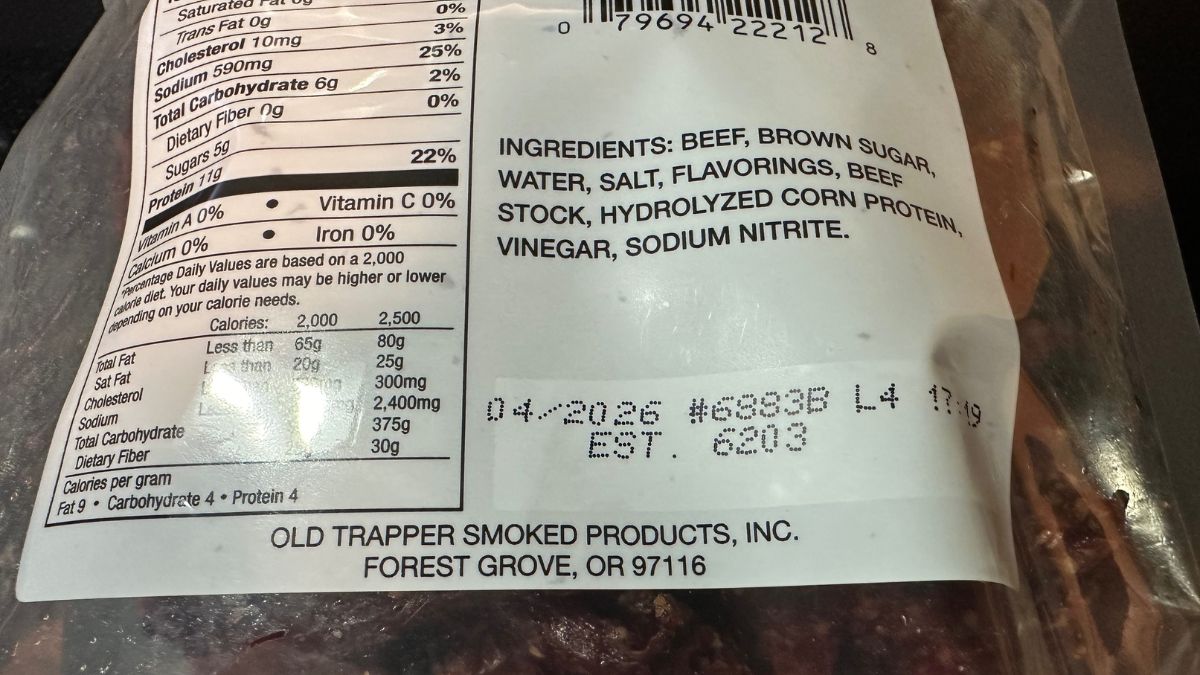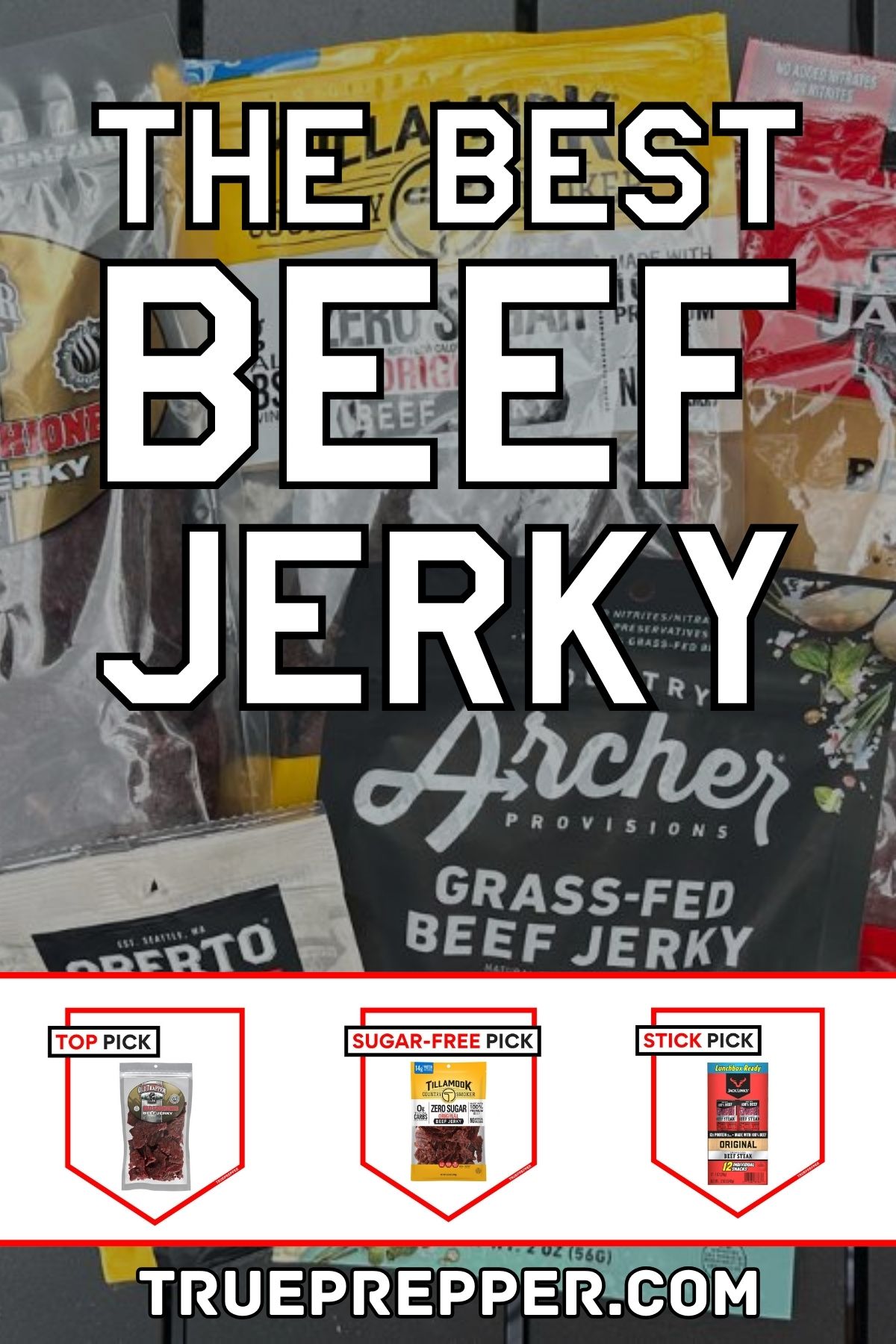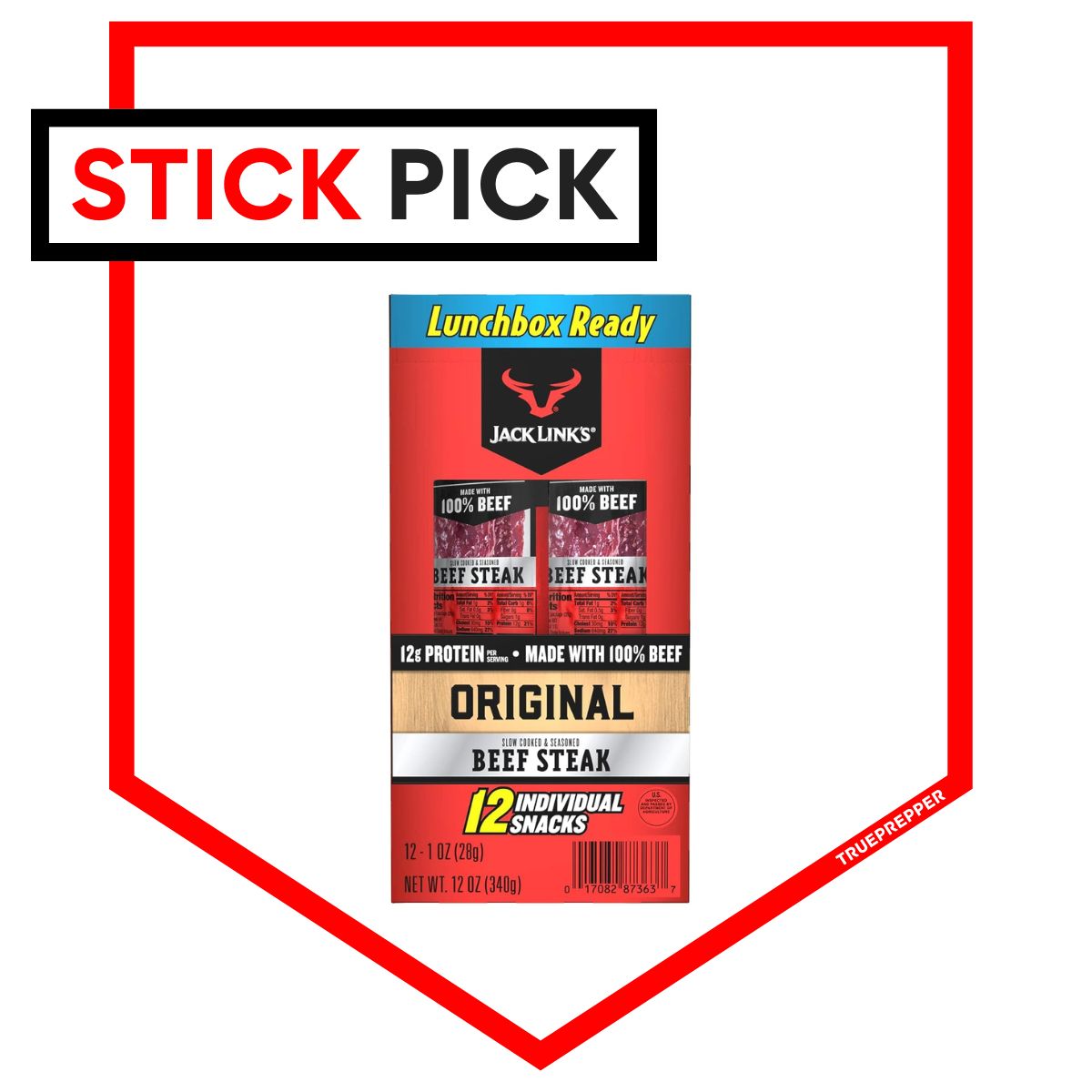Best Beef Jerky for Survival Kits Leave a comment
Dried and cured meat has been a survival staple since man discovered fire. Over time we’ve perfected it for taste and longevity, using high-tech industrial dehydrators and plenty of preservatives to have the commercially available jerky we have today. While it’s far from perfect, the best beef jerky can last years in a survival kit, bug out bag, or even a glove compartment. There are many brands and types of jerky to consider.
This is where we come in. We’ve broken down the ingredient and shelf life data on widely available beef jerky and then given them all a good old-fashioned taste-testing. With some jerky lasting years longer than others, we found the fat content to be an important consideration for expiration. Get one of our top picks in your favorite flavor to add serious protein and great taste to your pantry or kits.
Contents (Jump to a Section)
The Best Beef Jerky
Old Trapper Beef Jerky
Lean, Flavorful, and Long-Lasting
Negligible fat content gives this tough jerky twice the shelf life of other brands with a great classic taste to boot.
*Price at time of publishing; check for price changes or sales.
Old Trapper is widely available at grocery stores and big box stores and isn’t very expensive. They don’t dance around the fact that they use sodium nitrate as a preservative like other brands do (even though they all use nitrates). The great thing about Old Trapper is that they select extremely lean meat for their cuts to dehydrate. This results in the longest-lasting beef jerky by far in our comparisons. It was also proven by the printed ‘best by’ date comparisons, walloping the competition in our taste testing by several months.
Speaking of taste-testing, Old Trapper doesn’t taste bad at all for relatively cheap jerky. It isn’t low sodium, but the brown sugar balances the salty taste nicely. It’s not going to win any health-eating awards, but it does pack some protein and calories making it a solid survival choice.
Specs
- 6 flavor options: Old Fashioned (taste-tested), Peppered (my favorite), Hot, Spicy, Hot & Spicy, Teriyaki
- 10 ounces
- Clear windowed plastic packaging with oxygen absorber
- 24-month best-by date
If you want the best beef jerky for your survival kits, Old Trapper Beef Jerky tastes great and will outlast the rest.
No Sugar Beef Jerky
Tillamook Zero Sugar
Protein Packed, Sugar-Free, and Tasty
Skip the sugary taste and pack away some serious protein with this zero-sugar option getting plenty of traction lately.
*Price at time of publishing; check for price changes or sales.
Sugar does a pretty good job of balancing out salty taste but we all know that sugar isn’t the best for you. If you are eating jerky every day, or often enough to keep in your everyday carry- you might want to go for the sugar-free option.
Out of the sugar-free options, Tillamook took the crown in the nutritional breakdown, shelf life, and taste test. It lasts a long time in its packaging and has some of the highest protein by weight since sugar has been pulled out. It definitely has a salty taste, but you can also taste the meat flavor more clearly as well. I enjoyed the taste of the original flavor despite its simplicity and saltiness, and the other taste testers agreed.
The sugar free options do cost a bit more than other options, this one included. Still, your doctor may thank you if you eat a lot of jerky and it’s not a downgrade in taste- it’s just different.
Specs
- 4 flavor options: Original (taste-tested), Black Pepper, Hot & Spicy (my favorite), Teriyaki
- 6.5 ounces
- Clear windowed plastic packaging with oxygen absorber
- 18-month best-by date
If you’re looking for a jerky option without the sweetness, the Tillamook Zero Sugar Beef Jerky will do the trick.
Best Jerky Sticks
Jack Links Beef Steak
Lightweight, Protein-packed, and Convenient.
Individually packaged steak strips are easy to break up between survival kits for fast protein.
*Price at time of publishing; check for price changes or sales.
Jack Links is the most recognizable jerky brand in America, but not all of their jerky is the same, and not all of their stick options are either. The steak sticks blow away their regular beef sticks, which are more like Slim Jims. Those are packed with fat, whereas these steak sticks are lean like regular jerky but convenient in a long strip/snack form.
For individually packaged strips they aren’t bad on cost either, making them ideal if you need just a few sticks in survival kits, lunch boxes, or glove compartments. The shelf life isn’t as long as some jerky and they don’t include an oxygen absorber to help extend it.
The flavor is good and they are more chewy than regular jerky from the binder used to keep it in strip form. This doesn’t detract from the taste but the texture difference is noticeable. Still, the steak strips are much closer to the real deal than beef sticks from Jack Links and other brands.
Specs
- 4 flavor options: Original (taste-tested), Peppered (my favorite), Sweet & Hot, Teriyaki
- 12 sticks of 1-ounce jerky
- Clear windowed plastic packaging
- 12-month best-by date
The Jack Links Beef Steak Strips are a solid option for protein on-the-go and a much better option than slamming into a Slim Jim.
Everything We Recommend
The Jerky We Compared
Our research narrowed the field to several dried meat brands that we taste-tested and compared the nutrients and shelf-life on: Archer, Jack Links, Oberto, Tillamook, Old Trapper, Cattleman’s Cut, Slim Jim, and more.
We explain all of our taste testing criteria and nutrition evaluation in our What to Look For section.
The range of brands, types, and flavors of beef jerky is boundless with all of the ’boutique’ brands out there now. Unfortunately, those don’t pass the ‘value’ test, costing several dollars per ounce of dried meat. To keep things simple, we stuck with ‘original’ or ‘old fashioned’ style beef jerky to avoid flavor preferences, which don’t matter much for survival as long as you enjoy your pick.
Homemade beef jerky also only lasts a fraction of the time, so it didn’t make our top suggestions- but it is worthwhile if you have your own dehydrator.
Beef jerky isn’t the best survival food, but it’s convenient, tasty, and holds up well enough in the bag. While we tested most of the jerky available in stores, I’m always open to trying new brands and flavors if you have any suggestions. We review at least annually, so we’ll update if we find something better- so suggestions of your own favorites are always appreciated!
What to Look For
The best beef jerky for survival has a few things to evaluate:
- Value
- Taste
- Nutrition
- Packaging
- Shelf Life
Once you find and compare beef jerky with a solid blend of these, you’ll be able to pack some dried meat in your bag that’ll last plenty of months until you need to cycle through them.
Value: Cost Analysis
You shouldn’t blow out your budget on beef jerky. It can be pricey- especially if you are considering boutique brands, mail order, or specialty types of jerky. Budget beef jerky, on the other hand, can be poorly packaged, go stale quickly, and just have a bad taste.
The sweet spot lies in the middle, like most things. We used spreadsheet graphs to evaluate cost per ounce of beef jerky compared to other features like shelf life. This makes it easy to see which types of jerky look best ‘on paper’, but there is always still taste testing to be done.
Taste
Have you ever had bad beef jerky? I’m not necessarily talking about spoiled beef jerky- I hope you’ve never tasted moldy or stale jerky! I’m talking about beef jerky that just tastes bad.
Usually, this is when the manufacturer is just going through the motions on a specific flavor or type of jerky. I’ve had some pretty bad teriyaki and other flavors from big brands in my lifetime.
To keep the taste testing simple, our crew limited the jerky flavor to just ‘Original’ or ‘Old Fashioned’. While my own personal favorite is anything peppered or with heat, some of our taste testers preferred other flavors. Having all of us try the regular flavor put us on an even playing field and helped us compare tastes between the brands.
Nutrition
Besides how the jerky tastes and how good of a value it is, you should also consider its nutrition. For jerky in a survival kit, this is defined by calorie count and how much of those calories is made up of protein.
For each of our picks, we show how much of each ounce of jerky is in measured protein. We also show the fat, sugar, cholesterol, and sodium measurements. High sodium can affect taste, but it is also a preservative.
Sugar content can go either way, and arguments both for and against sugar in survival food has merit. Survival food bars and ration bars are loaded with sugar to provide energy. Loads of sugar aren’t exactly healthy if you plan on eating more often, so sugar-free jerky may be the way to go if you are using it in your everyday carry bag.
You may notice that fat is inversely proportional to the listed ‘best by’ dates that we show for our shelf life. Jerkies with less fat (or no fat) last significantly longer than higher fat brands since fat is tough to completely dehydrate even with industrial equipment.
Packaging
Almost every brand we tested used ‘windowed’ plastic bags (some resealable) with an included oxygen absorber that was various brands/sizes (but they are all iron oxide, of course).
We’ve reviewed the best oxygen absorbers and noticed a few of the top-quality absorbers in higher-cost jerky bags. The larger the bag, the larger the absorber that was included.
On the storage bags, quality was apparent in the plastic thickness and edge seal. Most brands printed that the jerky should be eaten within a few days of opening, even if they included a resealable closure. Multiple smaller bags may be ideal for your kits for this reason. Several 10-ounce bags may be better than the three-pounder.
Shelf Life
The best beef jerky we saw had a whopping 24-month listed ‘best by’ date on the packing, which was still at 22 months after distribution time after leaving the manufacturer. It’s able to accomplish that with a nominal level of fat in the beef cuts it selects, which is better for dehydration (as we pointed out earlier). It also uses robust packaging and a dependable oxygen absorber, and sodium nitrate.


All beef jerky should be stored in a cool, dry place out of sunlight for the best shelf-life performance. Many will last past the listed best-by date if they are stored properly. If you keep jerky in your car where it gets hot and/or humid, you should expect the shelf-life to be about half as long as normal. Always check jerky for mold or other spoilage before you eat it.
Homemade beef jerky has the least shelf life of 6 months sealed in ideal conditions. This is due to the fat content and home dehydrator limits on fully dehydrating it.
DIY Homemade Beef Jerky
Homemade jerky can give you a lot of flexibility in types of meat, cuts, and flavors. There are several ways to make jerky on your own, but the easiest is to use a home dehydrator.
Even though the shelf-life isn’t the same as manufactured, you can still get several good months of storage if you use mylar bags and oxygen absorbers to store your haul.
Other ways you can make jerky include running an oven at low heat or using an air fryer. Some even use marinated meat with sun curing or fan drying- but those take experience with trial and error to make work, and could still spoil your meat.
Here is an easy oven recipe:
Beef Jerky in Your Survival Kits
Beef jerky, as a survival food, is more convenient than anything else. Sure, it can pack some protein for it’s weight but it’s not the best option by nutritional or shelf life standards. Still, many preppers opt to keep it in mobile kits as a personal preference.
The main kits that you should consider beef jerky for include:
Many people also consider dried meat to store in their:
If you like the taste of beef jerky, it can add some variety and protein to your survival food strategy. I like keeping some peppered beef jerky on hand in a few of my kits because I like the taste and it is easy to replenish at most grocery stores.
How We Review Products: We research thoroughly before selecting the best products to review. We have vast prepping and survival experience and bring in outside experts when needed. Hours on end are spent testing gear in stressful conditions and using specialized testing gear to verify claims. We assign performance criteria and impartially rate each tested item. Learn more about how we test.
Sources and References
Beef jerky isn’t rocket science, but we still researched before we did all of our testing. Here are the sources we used to reference technical information in our review.
Holley, R. (1985). Beef Jerky: Viability of Food-Poisoning Microorganisms on Jerky during its Manufacture and Storage. Journal of Food Protection. Volume 48. Issue 2. Pages 100 – 106. (Source).
Park, C., et al. (2007). The Effects of Drying Method and Spice Extracts Added to Beef Jerky on the Quality Characteristics of Beef Jerky. Korean Journal of Food and Cookery Science. Volume 23. Issue 6. Pages 800 – 809. (Source)
Shi, S., et al. (2020). Comparison of the quality of beef jerky processed by traditional and modern drying methods from different districts in Inner Mongolia. Meat Science. Volume 163. (Source).
The Final Word
These food taste tests are always an adventure and I’m glad we were able to compare a wide range of beef jerky types and brands. It’s not the type of thing you would want to eat exclusively in an emergency, but good jerky does add some protein and great taste that’s convenient on the go.
Although we only tested the original-type flavors, picking your favorite flavor is a good idea since it doesn’t adjust the factors we considered much. Brand and type of jerky had a bigger impact than flavor choice in the nutritional profiles and shelf life.
Our subscribers have found these articles helpful as well:
We presented quite a lot of information, but as always: if you have any questions let us know and we would be happy to help. Our comparisons and taste-testing settled on Old Trapper Beef Jerky as the best option given the nutrition stats, shelf life, and value.
Keep exploring, stay prepared, and be safe.
You’ve Been Missing Out
Join the 2+ million preppers that rely on our prepping advice by subscribing to TruePrepper.
- Practical guides and tips
- Useful survival giveaways
- Free, forever
- < 0.4% of people unsubscribe


Please Support Our Sponsors
Solar Power Generator Discounts Along With Free Shipping
- 10% OFF for Jackery Solar Generator 2000 Pro Series with code "JADEAL"
- 10% OFF for Jackery SolarSaga 200W Solar Panel with code "JADEAL"
- 10% OFF for Jackery Solar Generator 1500 Series with code "JADEAL"
- 10% OFF for Jackery Solar Generator 1000 Series with code "JADEAL"
- 10% OFF for Jackery Explorer 1500 Portable Power Station with code "JADEAL"
- 10% OFF for Jackery Explorer 1000 Pro Portable Power Station with code "JADEAL"
- 10% OFF for Jackery Explorer 500 Pro Portable Power Station with code "JADEAL"
- 10% OFF for Jackery Explorer 300 Pro Portable Power Station with code "JADEAL"
- 10% OFF for Jackery SolarSaga 100W Solar Panel with code "JADEAL"

The University of Georgia is represented by the Georgia Bulldogs . The Bulldogs participate in the Southeastern Conference's (SEC) Eastern Division of the NCAA.
They play their home games in the storied Sanford Stadium in Athens, Georgia. The first season in Georgia was in 1892. In 1942, 1980, and 2021, the Georgia Bulldogs won three national championships.
The Georgia Bulldogs have additionally been crowned the National Champion in four additional seasons by at least one polling organization (1920, 1927, 1946 and 1968).
The Georgia Bulldogs are tied for second place in conference history with their 15 conference titles, including 13 SEC titles, and their 59 bowl appearances, which ranks second all-time.
In addition, the program has produced five top picks in the National Football League (NFL) draft, two Heisman Trophy winners, numerous winners of various national honors, and many others.

Longhorns football represents the University of Texas in Austin often known as Texas, UT or the Texas Longhorns. The Longhorns represent the Big 12 Conference in the NCAA Division. They play in Austin, Texas, at the Darrell K. Royal-Texas Memorial Stadium.
The Texas Longhorns are ranked third and seventh, respectively, in terms of all-time wins and win-loss records, with over 900 victories and an overall win-loss percentage of.705.
The legendary program also boasts four national titles, 32 conference titles, 100 First Team All-Americans, and two Heisman Trophy winners.
Get your Texas Longhorns Revival T-Shirt today. The Texas Longhorns Rustic Revival shirt is also a fan favorite.
Many college sports fans like to wear their gear all around town, get your Texas Longhorns Centered gear and show your support.







 Gettr
Gettr














